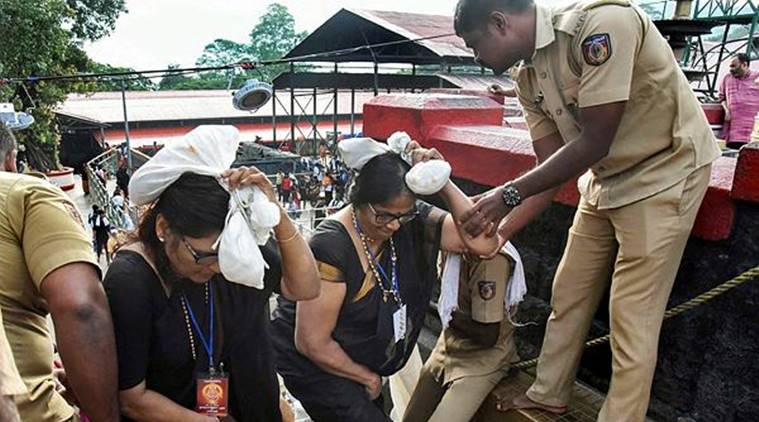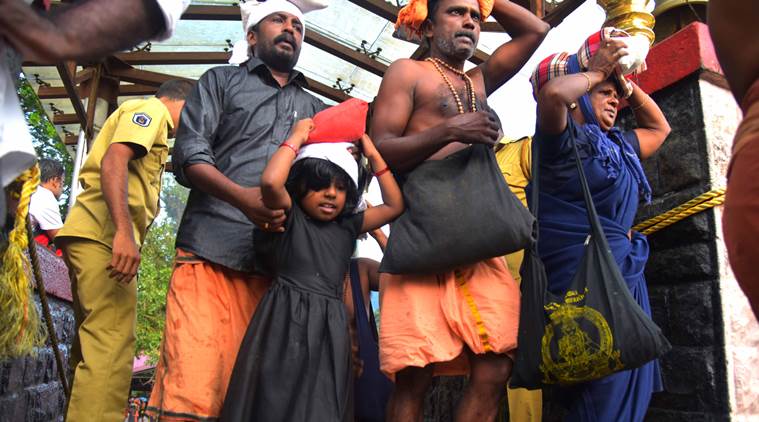On the streets of India and Pakistan, a frightening message is being sent out: that courts must not rush in where politicians fear to tread. In matters of faith, courts must simply sit on their hands and pray for divine intervention to resolve the petition before them. The public and political responses to Supreme Court judgments in two instances — Sabarimala in India and the Asia Bibi case in Pakistan — bear striking similarities. What is different, however, is the ability of the two states to enforce their writ.
Sabarimala is considered to be one of the holiest temples in Hinduism, with one of the largest annual pilgrimages in the world. The faithful believe that the deity’s powers derive from his asceticism, and in particular from his being celibate. Women between the ages of 10 and 50 are barred from participating in the rituals.
The exclusion was given legal sanction by Rule 3(b) of the Kerala Hindu Places of Public Worship (Authorisation of Entry) Rules, 1965. The validity of the rule and other provisions restricting the entry of women was decided by the Supreme Court last month. The Court, by a majority of 4:1, held that the exclusion of women between these ages was violative of the Constitution.
The Sabarimala judgment
Then Chief Justice of India Dipak Misra and Justice A.M. Khanwilkar held that the practice of excluding women did not constitute an “essential religious practice”. Crucially, the judges also relied on Section 3 of the Act mentioned above which stipulates that places of public worship must be open to all sections and classes of Hindus, notwithstanding any custom or usage to the contrary. It was held that Rule 3(b) prohibiting the entry of women was directly contrary to this. A concurring judge, Justice R.F. Nariman, further held that the right of women (in the age bracket in question) to enter Sabarimala was guaranteed under Article 25(1). This provision states that all persons are “equally entitled” to practise religion. According to him, Rule 3 prohibiting the entry of women, was violative of Article 15(1) of the Constitution.
Justice D.Y. Chandrachud, also concurring, emphasised the transformative nature of the Constitution which was designed to bring about a quantum change in the structure of governance. More crucially, it was a founding document, designed to “transform Indian society by remedying centuries of discrimination against Dalits, women and the marginalised”. ‘Morality’ used in Articles 25 and 26, the judge held, referred to constitutional morality which includes the values of justice, liberty, equality and fraternity.
Holy communion: It’s just the forests, the mountains and the Sabarimala temple on most days of the year. The place of worship comes alive only during the five-day monthly puja and the 41-day annual pilgrimage season beginning mid-November.
He also held that barring menstruating women from entering the shrine is violative of Article 17 (the constitutional provision prohibiting untouchability). The judge held that the concept of untouchability is grounded in the ideas of ‘purity and pollution’. These same notions form the basis for excluding the entry of menstruating women into religious shrines.
The sole woman judge, Justice Indu Malhotra, who dissented, reasoned, “Issues of deep religious sentiments should not be ordinarily be interfered by the court. The Sabarimala shrine and the deity is protected by Article 25 of the Constitution of India and the religious practices cannot be solely tested on the basis of Article 14... Notions of rationality cannot be invoked in matters of religion... What constitutes essential religious practice is for the religious community to decide, not for the court. India is a diverse country. Constitutional morality would allow all to practise their beliefs. The court should not interfere unless if there is any aggrieved person from that section or religion.”
While the Bharatiya Janata Party has seen the judgment as an attack on the Hindu religion, the Congress too has not lagged behind. Even an “instinctive liberal” such as Shashi Tharoor has said, “abstract notions of constitutional principle also have to pass the test of societal acceptance — all the more so when they are applied to matters of faith... In religious matters, beliefs must prevail; in a pluralistic democracy, legal principles and cultural autonomy must both be respected…”
He also held that barring menstruating women from entering the shrine is violative of Article 17 (the constitutional provision prohibiting untouchability). The judge held that the concept of untouchability is grounded in the ideas of ‘purity and pollution’. These same notions form the basis for excluding the entry of menstruating women into religious shrines.
The sole woman judge, Justice Indu Malhotra, who dissented, reasoned, “Issues of deep religious sentiments should not be ordinarily be interfered by the court. The Sabarimala shrine and the deity is protected by Article 25 of the Constitution of India and the religious practices cannot be solely tested on the basis of Article 14... Notions of rationality cannot be invoked in matters of religion... What constitutes essential religious practice is for the religious community to decide, not for the court. India is a diverse country. Constitutional morality would allow all to practise their beliefs. The court should not interfere unless if there is any aggrieved person from that section or religion.”
While the Bharatiya Janata Party has seen the judgment as an attack on the Hindu religion, the Congress too has not lagged behind. Even an “instinctive liberal” such as Shashi Tharoor has said, “abstract notions of constitutional principle also have to pass the test of societal acceptance — all the more so when they are applied to matters of faith... In religious matters, beliefs must prevail; in a pluralistic democracy, legal principles and cultural autonomy must both be respected…”
Asia Bibi case
In 1929, the funeral of a killer, Ilmuddin, took place in Lahore, executed for the murder of Rampal, a publisher, who had published an allegedly unsavoury reference to the life of Prophet Muhammad. Ilmuddin had been buried without funeral prayers as the authorities anticipated further trouble. But some eminent personalities, who included M.D. Taseer, assured the British authorities that there would be no trouble if there was a proper burial with a procession and Islamic prayers. The British relented and at the public mourning, the funeral prayer had to be read thrice before the surging crowds. The upshot of these events was that Section 295A was introduced into the Indian Penal Code to punish a deliberate insult to religious feelings.
Years later, in Zia-ul-Haq’s Pakistan, Sections 295B and 295C were added to the Pakistan Penal Code which criminalised blasphemy against Islam and even made it punishable with death. In 2009, Asia Bibi, a Christian woman, was accused of blasphemy by her neighbours and jailed pending trial. She was sentenced to death in 2010 by a trial court.
Her case became a cause célèbre and Salman Taseer, the Governor of Pakistan’s Punjab province, visited her in prison to express support. This act by Taseer, who was the son of M.D. Taseer who had negotiated Ilmuddin’s burial, did not go down well. So enraged was his bodyguard Mumtaz Qadri, that he assassinated Taseer in 2011. When Qadri was produced in court for trial, he was showered with rose petals by lawyers. He was tried and hanged in 2016, and his funeral attracted a crowd that rivalled the one at Ilmuddin’s.
Last month, the Supreme Court of Pakistan allowed Asia Bibi’s appeal and declared her innocent of the charges. She has now been released and expected to be granted asylum in Europe. Her lawyer has fled Pakistan and the judges now fear for their lives. Pakistan faced the threat of mob violence led by the radical Tehreek-e-Labbaik Pakistan party. Despite Prime Minister Imran Khan’s initial bluster, an agreement has been signed with mob leaders to end the violence.
The Chief Justice of Pakistan, Saqib Nisar, has reportedly defended himself by saying, “No one should have the doubt that the Supreme Court judges are not lovers of Prophet Muhammad... How can we punish someone in the absence of evidence?”
The thread
It is easy to dismiss the Sabarimala and Asia Bibi cases as being unconnected and belonging to different jurisdictions and contexts. But both belong to the same region and trajectory of history. India was built on a secular foundation while Pakistan was built on a majoritarian Muslim agenda. However, both countries profess at least lip service to the rule of law. Years of majoritarianism have brought Pakistan to the point where its institutions have had to defend themselves before doing justice to minorities. India is at a stage, where its majority is seeking to bring its institutions to acquiesce in majoritarian instincts. A majority whose forebears had committed themselves to a magnificent constitutional compact now has elements who seek to regress from those values.
The question is whether the people and the institutions succumb to pressure or adhere to principle. Each individual, regardless of birth ascribed identity, is a minority of one entitled to an individual guarantee of rights protected by the Constitution. It is in the adherence to individual rights that the greater public good rests. Those who sacrifice a little man or woman’s liberty for the security of the many will find neither liberty, nor security.
Let us keep this in mind, as the Supreme Court agrees to hear in open court a review petition against its Sabarima judgment.





